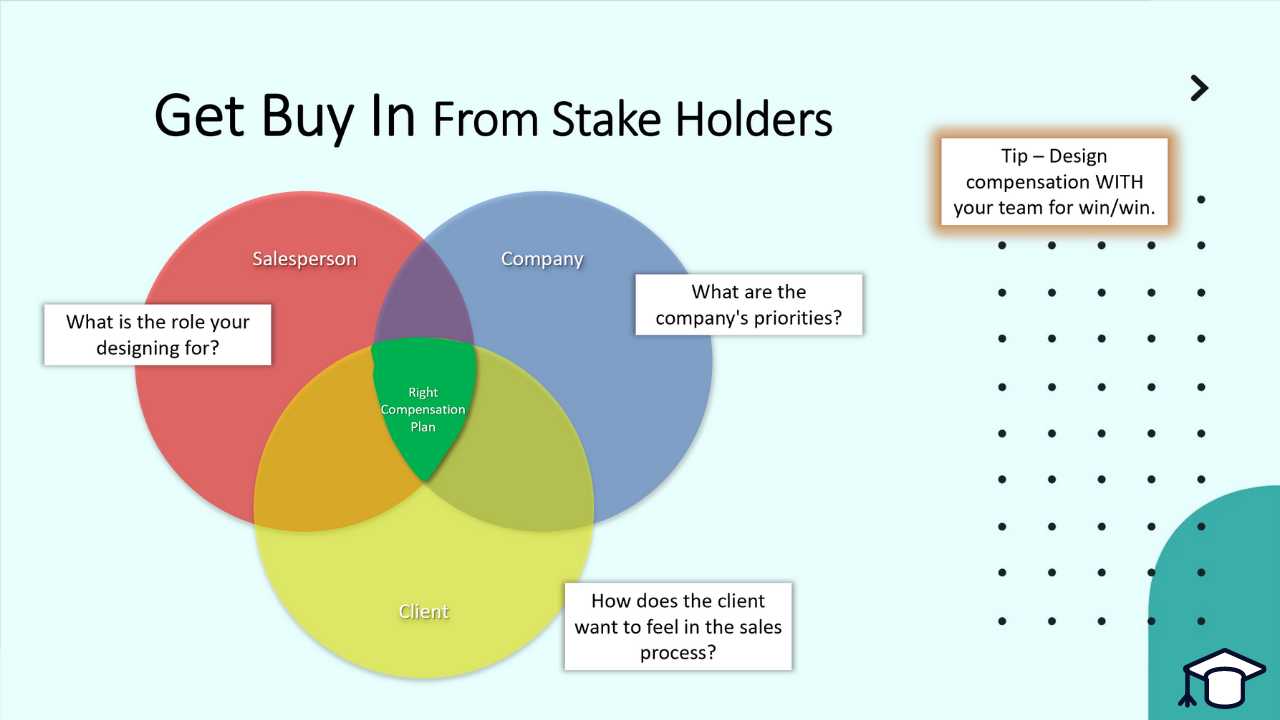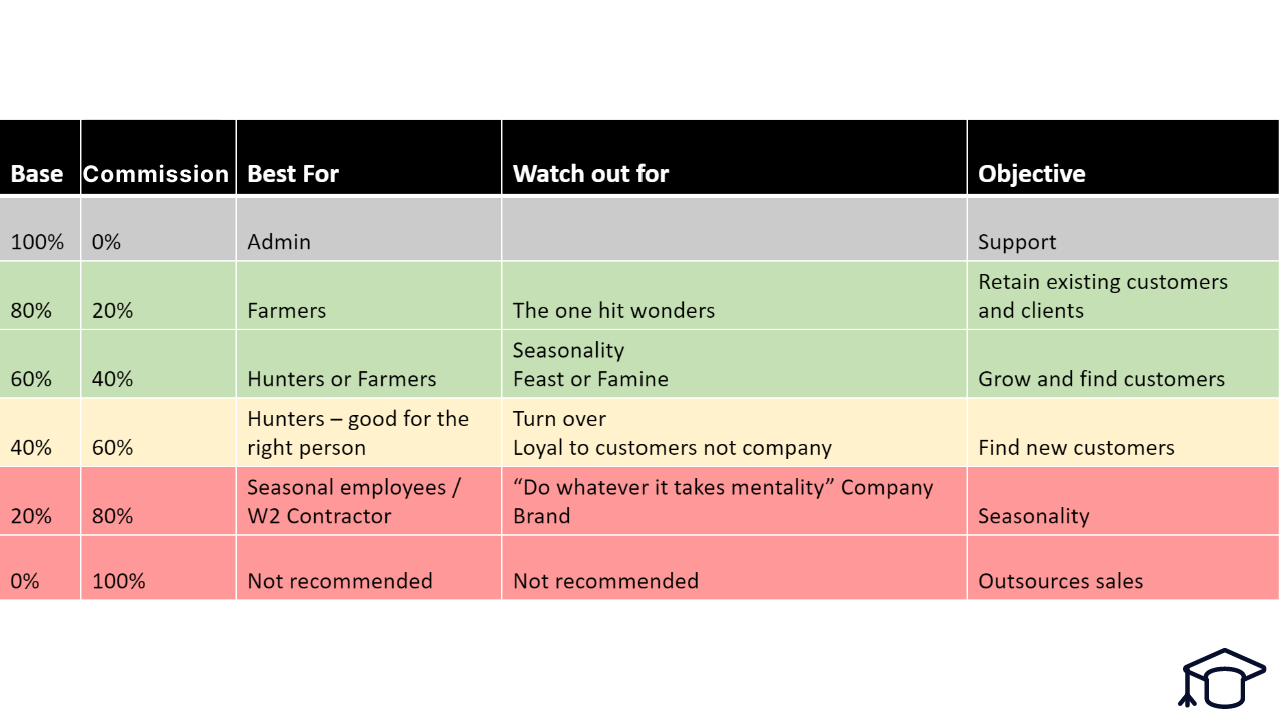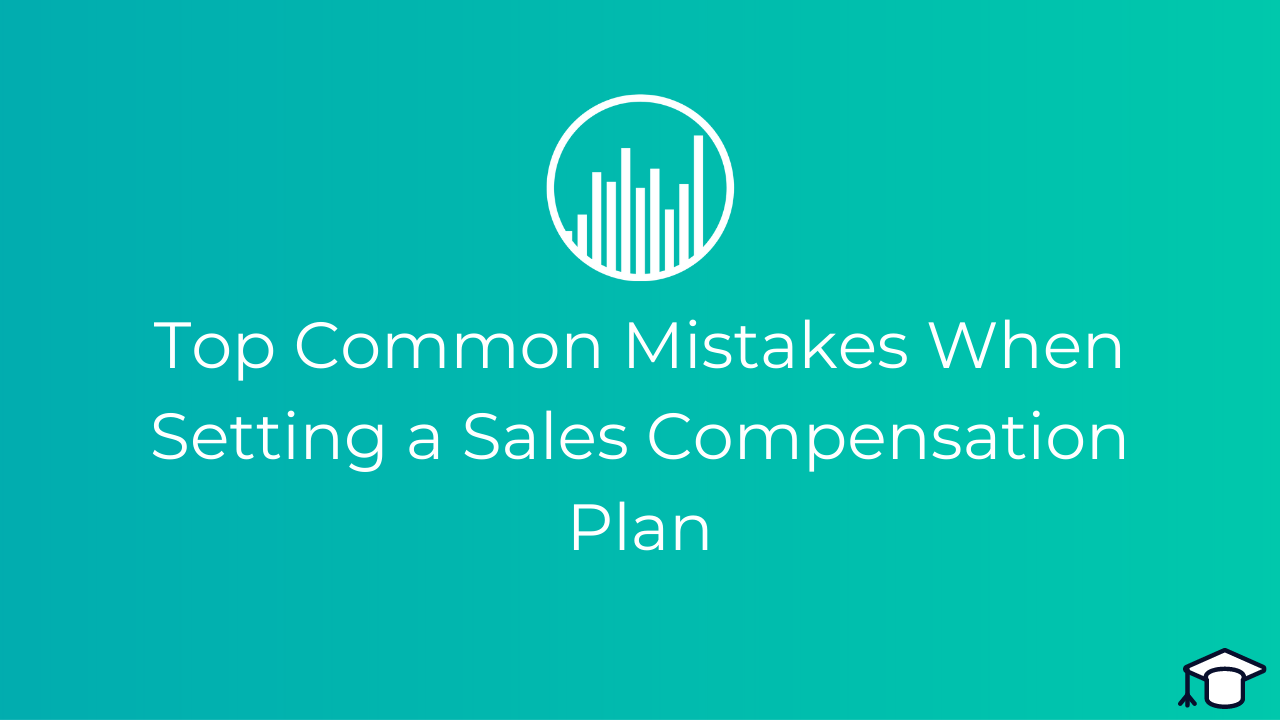When designing a compensation plan, we want something that is a win-win and works for both the company and the employee. We also want the compensation plan to drive the sales team’s behaviors and their goals so that they’re motivated, and it’s used as a tool to help everyone make money.
We’ve created a model below for compensation plans so that it gives you a framework to structure your plan.

The number one thing you need to do when it comes to creating a compensation plan is to get buy-ins from all the stakeholders. In our model above, we have the three stakeholders you need to be considering when designing a sales compensation plan. Number one is the salesperson. Number two is the company. And the third one, which no one talks about, is the client. The right compensation plan is going to be right in the middle, which is going to be beneficial to all three.
When you’re considering the salesperson, ask yourself, “what is the right role that you’re designing for?” Is it residential? Commercial? Large service jobs? Small service jobs? GCs? Each type of role is going to have a different compensation plan.
Maybe you have salespeople who sell everything. If that’s the case, the way you’re paying them is likely all over the place and they could start taking advantage and working the compensation plan in a way that’s putting the company at risk. It might be better to start dividing those roles to allow for a more structured plan. For example, you could have one salesperson focusing on residential and one focusing on commercial. This will allow you to create an appropriate comp plan that works for both employees.
The next thing to consider are the company’s priorities. Maybe you want to push warrantees this year or maintenance plans. Maybe you want to push a certain type of roof or certain type of HVAC unit. Define your company goals and priorities. Maybe you’re trying to grow a particular decision this year. If your company priorities are more aggressive and you’re trying to dominate the market more, you’re going to have a different compensation plan.
The third thing to consider in our model is the client. Ask yourself, “How do you want the client to feel in your sales process?” This is important to consider because if your client fees like your salesperson is beating them up for a sale, a lot of that is manufactured by your compensation plan. Some call this “commission breath.” If you’re a residential company where the client and salesperson relationship is more transitional, then maybe this is how you want the client to feel, to a certain extent. But for a large commercial job that takes 18 months to close, on month three, it’s not appropriate to make the client feel this way. Understanding the sales process by each job type and how you want the client to feel is key when it comes to creating a comp plan.
A hot tip is to design your compensation plan WITH your team for a win/win/win. Oftentimes, compensation plans are designed behind closed doors and THEN presented to the sales team. So often when this happens, salespeople feel like you did not have them in mind when creating the comp package. People are generally reasonable and know that the compensation plan can’t only be a win for the salesperson. Allowing your sales team to participate in your comp plan design is a great way to make them feel included, heard and motivated.
We recently saw a company create a compensation plan behind doors and when they presented it to their sales team, they were pretty upset by it. He then offered to go through the compensation plan with them and allow them to participate in the design, and by the end of it, the sales team realized that the original plan was the most beneficial plan for the salespeople, company and client. Be open and transparent about your plan and keep your team in loop so they feel included in the process.
You’ll know you’ve designed the right compensation plan for the right results when you see the puzzle pieces come together. Compensation plan alignment is one of those pieces that ties everything together and you’ll know when that puzzle piece fits because your sales team will be behaving appropriately.
Below, we’ve broken down a comprehensive framework to help with planning the right comp package.

The framework above breaks down base and commission, who it’s best for, behaviors to watch out for, and your company objective that best aligns with each package plan.
If you’re providing a 100% base salary for your team and 0% commission, that’s best fit for an administrative type of role or a sales support role such as a receptionist. This is generally not a good fit for a salesperson because if you’re in a sales position, you’re typically a motivated type of employee that wants to make a large income. This type of compensation plan is not attractive to someone in a sales role.
The second plan is the 80% base pay and 20% commission. This package is best fit for farmers. Farmers are those working large commercial jobs, general contractors, and relationship managers.
The thing you need to watch out for with farmers is what we call “one hit wonders.” This means they might close a $1,000,000 job and then coast for the rest of the year because they made their money and don’t feel the need or drive to do more. It’s important to make sure your farmers don’t turn into “one hit wonders” and design a compensation plan that allows you to look out for those signs.
The objective for those with this compensation plan is to retain existing clients and grow them. As someone with this objective, you’re not going to be very pushy and the compensation plan is going to map to that.
Next is the 60% base and 40% commission plan. This is one of the most common compensation plans. This package is a good fit for both hunters and farmers. The 60/40 plan has to be appropriate for the right personality type. Some farmers can live with this, and some can’t. And the same goes for hunters. You’re really going to have to understand the unique individual.
The thing you have to watch out for with this compensation plan is the seasonality of your business and feast or famine. For example, if you can’t do a lot of selling due to snow, hurricane season, or whatever the reason may be, and you make all your money in the first six months of the year, that’s going to be financially tough for the company. It’s important to make sure your salespeople are still bringing in revenue throughout the rest of the year.
The 60/40 plan is a great plan if you’re looking to grow, find new customers, and take market share of your local market. This is more of an aggressive compensation plan, designed to incentivize people to get out there in the market development business.
The next plan is the 40% base pay and 60% commission. This plan is best fit for hunters in the residential, seasonal space who are looking to sell, sell, sell. The 40/60 plan is designed for those salespeople who know how to get out there and get results.
One important thing to watch out for is turnover. Oftentimes, these compensation plans tend to drive higher turnover rates because if there’s a three-month season where they’re not making any sales, they’re going to fall off the map. Typically, they’re not loyal to your company and are more loyal to the customer. Sometimes, this isn’t the best scenario, and in some unique situations, it is.
The objective for those in this role and comp plan is to find new customers. If you’re doing large commercial jobs or are in the commercial space, this compensation plan is not the best fit. However, if you’re in the residential space and depending on your company culture and what you’re trying to achieve, the 40/60 plan may be a good fit for you.
Next is the 20% base pay and 80% commission. We labeled this in red because it’s rare that we’d recommend this type of compensation structure. However, if you have seasonal employees or contractors who are trying to outsource sales quickly, maybe due to a weather event that requires a fast return, then this plan might work for you. Be cautious, though, that people are going to have a “do whatever it takes” mentality and the company brand could potentially be at risk if you hire employees that are slashing and burning out there. You don’t want your employees desperately pressuring people to close a sale. While, on the other hand, if you’re a seasonal business and have a spike, then this could be a fit for you.
Last, is the 0% base and 100% commission plan. This package is not something we’d recommend. Some companies like this structure, but it’s always good to have some buy-in to the company and what you’re building. With a 100% commission, sometimes it’s better to just start your own company.
Remember, no compensation plan is a one size fits all type of plan. Every company and scenario are unique and it’s important to design a compensation plan that is right for your company, employees, and the client.
Download Our Free Sales Compensation Plan Template
If you're struggling to put together the right compensation plan for your team, download our Free Sales Compensation Plan Template. This template breaks down multiple different package levels along with potential earnings. Happy planning!
-1.png)







